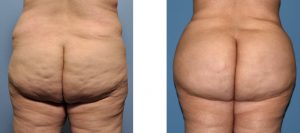1. Why would someone want their buttocks bigger?
The shape and size of the buttocks, like the breast, is highly influenced by race and culture. African-Americans, Latinos, and South Americans place more aesthetic priority on the buttocks than most Caucasians. They desire fuller and rounder buttock dimensions. Unfortunately, no amount of diet and exercise can increase buttock size. Nor can any topical cream or pill.
Buttock augmentation is the surgical implantation of natural grafts or synthetic implants to add volume and better shape to the buttocks. Patients who have volumetric buttock enhancement report their clothes fit more like they want and their confidence levels are improved with a fuller, better shaped derriere.
2. What is a Brazilian Butt Lift and how does it differ from buttock enlargement?

Using excess fat from other areas of the body, the fat cells are removed by liposuction
and then reinjected into different layers of the buttocks. The fat must be placed strategically through tunnels in layers for a smooth and natural result. This method is obviously natural and that is very appealing to many potential patients. With this fat transplantation method, there is no chance of the body rejecting the fat cells. But the cells are sensitive and careful surgical technique is needed to get them to live and make for a good result.
3. What are the risks of buttock augmentation using injectable fat grafting?
Like all operations, enlarging one’s buttocks with fat does have some risks. The biggest risk, however, is not that of any serious adverse effect. Rather, the main risk is that the take or survival of the fat grafts is unpredictable. No one can precisely predict how much of the injected fat will live. For this reason, when possible, more fat is put into the buttocks than necessary accounting for some resorption after surgery.
In about 20% to 30% of patients who have had buttock fat grafting, significant fat absorption occurs early on necessitating a second grafting procedure. While the goal is not to do more than one operation, patients choosing to undergo this method of buttock augmentation must be willing to accept this potential outcome. Aside from absorption, occasionally a minor touch-up may be necessary to correct minor irregularities or asymmetry. Other risks which are very uncommon include infection or sterile fat abscesses.
4. What are the advantages of buttock augmentation with implants?

They are made from a very soft and flexible silicone rubber material so they will not feel too firm or stiff. When implanted into the gluteal muscle, as they most commonly are, they will feel merely like a larger muscle. Contrary to popular belief, you did not sit on the implant after surgery. To do so would mean that the implant has been placed too low on the buttocks. The implant is positioned on the upper two-thirds of the buttock.
5. What complications can occur with buttocks implants?
Because a buttock implant is a foreign body, there are several untoward effects which can occur. These include the potential for an unnatural feel, infection, seroma (fluid accumulation), asymmetry, possible nerve injury (if placed under the muscle),and prolonged postoperative pain.( if under the muscle)
Another important consideration is that one’s recovery will not be insignificant. Manipulating the gluteus muscle, and having to sit and lay on it after surgery, is more than just mild discomfort for a few days. You can sit from the first day of your buttock enlargement surgery. However, sitting for prolonged periods of time right after surgery is not encouraged.
6. Are there any special garments that I need to wear after buttock augmentation surgery?
Patients will wear a special surgical garment, a compression girdle, for 1 to 2 weeks after surgery for comfort and to minimize swelling. During the first week, it should be worn all day except for showering. During the second week, it may be taken off at night time. It is also beneficial to have massage and ultrasound treatments, if possible, to minimize swelling, hardness, and to expedite one’s recovery.
7. When can one return to work and resume exercising after buttock augmentation?
Most patients can resume light exercising after 3 weeks, gradually getting back to unrestricted working out by 6 weeks after surgery. Depending upon the physical nature of your job, one can return to work in a sit down type job in 10 to 14 days. More physical jobs can take as long as 3 weeks to a month to feel comfortable performing the job adequately.
Barry L. Eppley, M.D., D.M.D.
Indianapolis, Indiana


